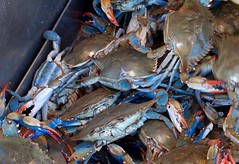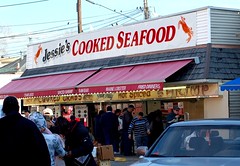
Giddy with excitement! I'm feeling really bubbly due to tonight's unexpected success. :)
What you have to realize is that I had no desire to cook. None. Our house was a pigsty, with semi-unpacked luggage and unopened mail and magazines and various electric cords and clothes all over the place. The drain in the kitchen is on the spritz, making dish washing very slow and frustrating. We're also still moderately sleep-deprived from the late Austin flight and haven't been to a grocery store for a week. Ugh. None of the above is conducive for culinary inspiration. It's Leftovers Night.
But! Leftovers....put leftovers on bread...and you get... PIZZA!! Leftovers = blah, but Homemade Pizza = sophisticated party! The very thought of it magically transformed our messy apartment into an "artistic" Yuppie loft (at least in my mind's eye). Pour some leftover cornerstore Chianti, turn on some Jazz (or better yet, some very hip bluegrass from Austin -- you have to be really in-the-know to play Texas
bluegrass in your "loft" while sipping cheap chianti), and suddenly the world looks so much better. I even got inspired enough to do a load of laundry and face the evil kitchen drain, and D swiftered the hell out of the living room.
In general, I've found homemade pizza to be one of those quick, easy but fun and surprising entertaining ideas, at least when we've invited other twenty-somethings over. When you're in our age bracket, a "dinner party" means either a) order pizza an

d bring beer or b) feel really awkward as the host(ess) "plays grown-up" and serves poorly executed, complicated food which you eat on plastic plates. I know, I've done both. One of the most successful dinner parties we've had since moving to D.C. was when we had a couple of D's Physics graduate student friends over and made pizza dough and had everyone "design" their own pizzas. No dirty pots, didn't even have to turn on the stovetop. We just let everyone loose into the kitchen to grab a bit of this and a bit of that and design the perfect pizza. Sounds like a trick that would work with preschoolers you say? Well, I won't dwell on the comparison between preschoolers and graduate students, but it was a hellova a lot of fun and not at all pretentious. Which is a fine line to walk when you're a twenty-three year old foodie who collects wine.
Now, you can serve "homemade" pizza by picking up pizza dough from the freezer in ye local grocery store. Or, you can make reasonably yummy dough pretty easily by hand. Or, you can produce Superlative pizza dough by using the
best Bread Cookbook I have ever encountered.
Richard Bertinet, a French baker based out of Bath (UK), revolutionized my whole approach to bread. D received his
Crust cookbook from my grandparents for Christmas, and we were so impressed with it that we immediately purchased Bertinet's first book,
Dough. The former deals with sourdough and other intense breads, and the latter with doughs that require only one rising. The amazing thing about Bertinet is that he is able to teach you how to "feel" bread

-- how to interpret what your senses tell you, what is going on, what are you trying to achieve, what should it look like... with very very precise, comparative photos. Kind of like the Cook's Illustrated approach, only a LOT MORE photos and explanations, and without getting into his learning process. There's even a full-page chart explaining how the weather will affect the rising.
Best of all is his technique for "kneading" the dough. Instead of the common "punch" method, which stretchs dough out, he uses a slap-and-pull technique that captures air inside the dough. Essentially, you grab a rectangle of dough from one end and slap the front end onto the counter, then take the end that you're holding and lift up and over... and grab the dough that's stuck to the counter, capturing air between the two parts of the dough rectangle. You clearly have no idea what I'm talking about, but he's got several pages of photos and a dvd is included in the books to explain the technique. The first time I used his method, it was like magic

-- the dough became this vibrant, living being, unlike any other bread I had made before. Using his technique and a higher ratio of liquid to flour, I ended up with gorgeous French baguettes. Who needs Julia Child's 18 page recipe, when you can bake bread on a worknight using Richard Bertinet? If I had to throw away all but one cookbook in my collection, his would be the one that I would keep. (If I could keep two cookbooks, it would be his and something by Madhur Jaffrey; both use techniques and an understanding of ingredient proportion that I just can't replicate on my own).
Okay, enough evangelizing. Now that I'm up here on the podium, I would also like to thank my little brother, who gave me a bread stone for my 23rd birthday, without which this pizza would have been no where near as good. No question, bread stones are WORTH IT. The difference is immeasurable. I would also like to thank D's Dad, who loves to feed our kitchen fetishes, and got us our kitchen scale. Without you, none of this would have been possible.
and, for those of you keeping track, this was a 100% vegetarian meal. We used some leftover tomato sauce, parmesan, spinach, fresh tomatoes, olives, capers, dried basil, hot peppers, and more parmesan. Maybe our eating habits did change with
that whole Lenten experiment.
Richard Bertinet's Pizza Dough (3 pizzas)
We halved this recipe to make one big pizza for the two of us, and finished half.
1/2 oz fresh yeast
18 oz Italian white bread flour (3 3/4 - 3 7/8 cups)
2 tsp fine grain salt
5 Tbs Olive Oil
11 1/2 oz Water

- Rub yeast into flour with your fingertips. Ass salt, olive oil, and water, and then use Bertinet's slap and pull method (described above, or just buy the book). Let the dough rise for 1 hour or so (it always needs at least 2 hours in our house) or, to acheive a better crust and taste, rest it overnight in the fridge. By doing this, you will enable the dough to rise very slowly and it will develop a little acidity that will improve its flavor and give a texture that is crispy on the outside and slightly chewy inside. Preheat oven to 475 degrees.
- Gently turn the dough out onto the counter and let it rest for 10 min more. Lightly flour the counter and place the ball of dough upon the counter. Divide into three.
- Place the heel of your hand in the center of each piece of dough and push it away from you so that it stretches the dough out. Turn slightly and repeat. Keep stretching the dough until you have a roughly circular pizza shape of about 8-9 inches in diameter. The edge should be slightly thicker than the dough in the middle.
- Lift the pizza base onto a piece of parchment paper and add toppings. Put the parchment + pizza onto a peel (or cutting board or flat cookie sheet) and slide it into your oven (preferably on top of your baking stone, or a preheated baking tray as a substitute). Turn the heat down to 460 degrees and bake for 10-12 minutes until the edges become golden brown and crispy.

 As D and I keep hinting, but have yet to really explain, we are wine people. We first realized that we were 'more than friends' while tasting Rieslings at a Rotenberg vineyard in Baden-Württemberg, Germany (just outside Stuttgart). I had a summer internship in Geneva and had taken the train up to visit D, a college acquaintance who was doing research at the Stuttgart University. One of his mentors had taken it upon himself to introduce D to classical music and to wine; D gleefully passed on his new-found appreciation as soon as I got off the train. Both he and the Rieslings totally knocked my socks off. One year later, we did a 3 week trek through Europe and brought back over 20 bottles of Wurttemberg wine in our backpacks (I have renowned packing skillz). Two years later, our wine collection topped 100 bottles, not counting the hard liquor, and dominates the central room in our apartment. And right around the three year mark, we'll be moving to the doorstep of California wine country! Life is good.
As D and I keep hinting, but have yet to really explain, we are wine people. We first realized that we were 'more than friends' while tasting Rieslings at a Rotenberg vineyard in Baden-Württemberg, Germany (just outside Stuttgart). I had a summer internship in Geneva and had taken the train up to visit D, a college acquaintance who was doing research at the Stuttgart University. One of his mentors had taken it upon himself to introduce D to classical music and to wine; D gleefully passed on his new-found appreciation as soon as I got off the train. Both he and the Rieslings totally knocked my socks off. One year later, we did a 3 week trek through Europe and brought back over 20 bottles of Wurttemberg wine in our backpacks (I have renowned packing skillz). Two years later, our wine collection topped 100 bottles, not counting the hard liquor, and dominates the central room in our apartment. And right around the three year mark, we'll be moving to the doorstep of California wine country! Life is good. challenging and sophisticated than most other food magazines on the market. In the April 2008 issue, Food & Wine did a fairly mediocre travelogue article on Texas Hill Country vineyards. I don't know if I was more indignant at the poor quality of the writing, or more pleased that Hill Country wines are finally starting to get recognized in the mainstream foodie culture.
challenging and sophisticated than most other food magazines on the market. In the April 2008 issue, Food & Wine did a fairly mediocre travelogue article on Texas Hill Country vineyards. I don't know if I was more indignant at the poor quality of the writing, or more pleased that Hill Country wines are finally starting to get recognized in the mainstream foodie culture.  e it to say, it was one of the best reds we'd ever had.
e it to say, it was one of the best reds we'd ever had.  their port was about as subtle as a sledgehammer. What's surprising is how quickly the vineyards are finding their sweet spots: that 2004 Super Texan that we adore was that vineyard's first harvest of Sangiovese grapes! Simultaneously, it takes a real gutsy cowboy to try wine-making in Texas. A bad drought in 2006 means that Flat Creek's Sangiovese grapes were nearly wiped out and they'll have to truck in someone else's -- so our glowing praise doesn't necessarily apply to the 2006 Super Texan!
their port was about as subtle as a sledgehammer. What's surprising is how quickly the vineyards are finding their sweet spots: that 2004 Super Texan that we adore was that vineyard's first harvest of Sangiovese grapes! Simultaneously, it takes a real gutsy cowboy to try wine-making in Texas. A bad drought in 2006 means that Flat Creek's Sangiovese grapes were nearly wiped out and they'll have to truck in someone else's -- so our glowing praise doesn't necessarily apply to the 2006 Super Texan!





















 Regardless of what the blooming tree outside our bathroom window claims, it's not spring here yet. No asparagus, tomatoes, or fresh greens that aren't the prodigal children of California or Chile. As I whined in
Regardless of what the blooming tree outside our bathroom window claims, it's not spring here yet. No asparagus, tomatoes, or fresh greens that aren't the prodigal children of California or Chile. As I whined in 

















